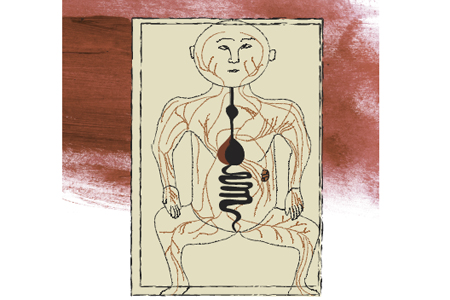
Inspired by Islam - Pulmonary Circulation
Issue 6 Jun / Jul 2004
First Published on July/August 2004
To access the issue page, click here
William Harvey is accredited with the discovery of the pulmonary circulation. However, many academics (both in Europe and the Islamic World) claim that the inception of the pulmonary circulation did not lie in Renaissance Europe but in thesands of Egypt and, in particular, belonged to the prominent Muslim physician, Ibn al Nafis (1210-1288 AD).
Ibn Nafis was born in a small town near Damascus in approximately 1210 AD. He joined the medical fraternity at the age of 22 and studied the works of many distinguished scholars including Rhazes, Ibn Sina, Galen and Hippocrates. Later, ibn Nafis moved to Cairoon receiving an invitation from the Sultan of Egypt to work in the Al-Naseri Hospital as an ophthalmologist.
Galen (the ancient Greek physician) had suggested that blood from the right side ofthe heart went through invisible pores in the cardiac septum into the left side of the heart where it was mixed with air. This ‘substance’ he postulated was distributed around the body.Given his status, this theory remained largely unchallenged for 1000 years until the time of ibn Nafis.
He wrote ten books on medicine and one on philosophy. One book was entitled Sharh Tashrih al Qanoun meaning ‘Commentary on the Anatomy of the Canon’, and was largely based on Ibn Sina’s ‘Canon of Medicine’. In this book he criticized the short comings of Galen’s theories on five separate occasions and described in unmistakable terms the pulmonary circulation as he envisaged it. He postulated that blood from the right ventricle of the heart travels to the lungs via the pulmonary artery and not by ‘invisible pores’ as Galen had theorized. Here, it “mingled with air” and then entered the pulmonary vein which transported the blood to the left ventricle. Ibn Nafis wrote in his Commentary on the Canon:
“The blood from the right chamber of the heart must arrive at the left chamber, but there is no direct pathway between them. The thick septum of the heart is not perforated and does not have visible pores as some people thought or invisible pores as Galen thought. The blood from the right chamber must flow through the vena arteriosa (pulmonary artery) to the lungs, spread through its substance, be mingled with air, pass through the arteria venosa (pulmonary vein) to reach the left chamber of the heart…”
Ibn Nafis further highlighted his theory by also commenting on the anatomy of the circulation, notably the heart and lungs. On this he also challenged the views of his predecessors, Galen and Ibn Sina: “And his (Ibn Sina) statement that the heart has three ventricles is not correct, as the heart has only two ventricles…”The preceding excerpts provide evidence for the claim that ibn Nafis postulated the theory of pulmonary circulation three hundred years before any of the Renaissance thinkers in particular, Michael Servetus, Realdo Colombo and William Harvey.
Many historians in this field, including Temkin, claim that the Renaissance scientists did not have access to ibn Nafis’ works, and thus Harvey and his Italian predecessors arrived independently at the same conclusion.
However, other historians have shown that this may not have been the case. Some of Ibn Nafis’ works were translated by Andreas Alpago of Belluno. His nephew, Poalo, had been a close companion of Colombo (whose ideas influenced a long line of physicians including Harvey). Some historians (eg. Abouleish, Meyerhof and Mieli) believe that Servetus plagiarised some of ibn Nafis’ works since many of the key phrases in his passage on the pulmonary circulation are similar to Ibn Nafis’ commentary. Meyerhof states that, “it is as though the Arabic work had been translated a bit freely into Latin”. Although the manuscripts of Ibn Nafis may not have reached the Renaissance thinkers in a printed form, they may have reached the West by word of mouth.
“In the history of mankind there are persons whose importance is revealed with the flight of time and their truth glows with the passage of centuries; Ibn al-Nafis is one of those.” (Abbouleish, E.)
Ibn Nafis also made significant contributions to ophthalmology: he devised some of the treatments for glaucoma and also described some of the anatomy relating to the eye. People today should be inspired by Ibn Nafis. Not only was he a physician, but Nafis was also a linguist, philosopher and historian. He was a leading expert on the Shafei school of thought and taught at the al Masrouriah School.
Bookmark this |
|
Add to DIGG |
|
Add to del.icio.us |
|
Stumble this |
|
Share on Facebook |
|
Share this |
|
Send to a Friend |
|
Link to this |
|
Printer Friendly |
|
Print in plain text |
|


Comments
0 Comments